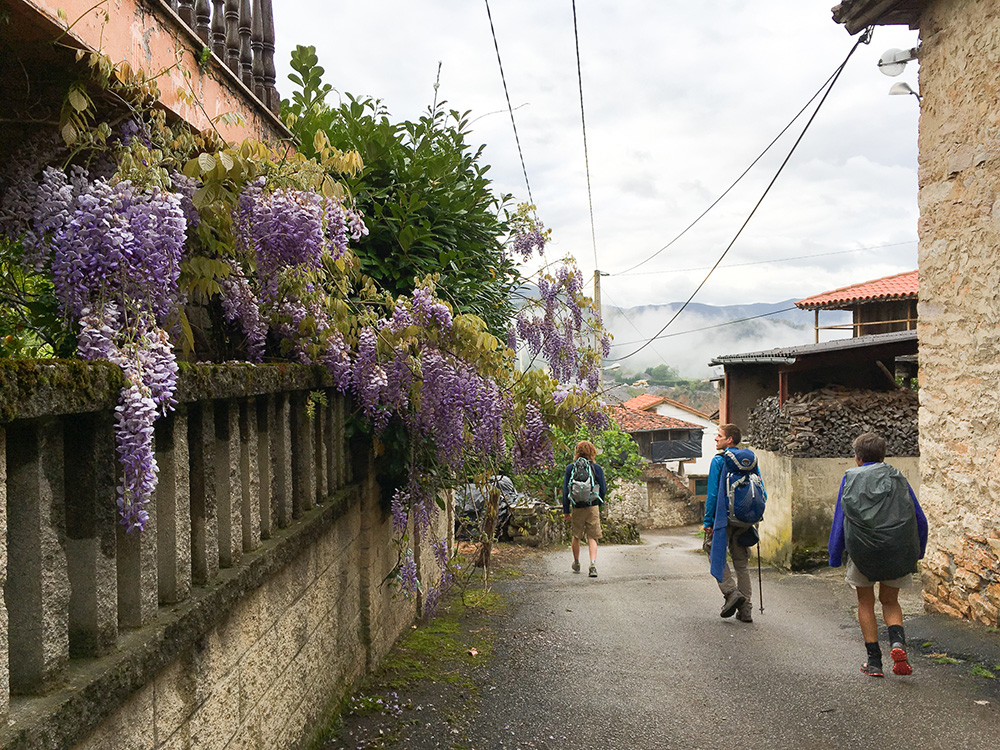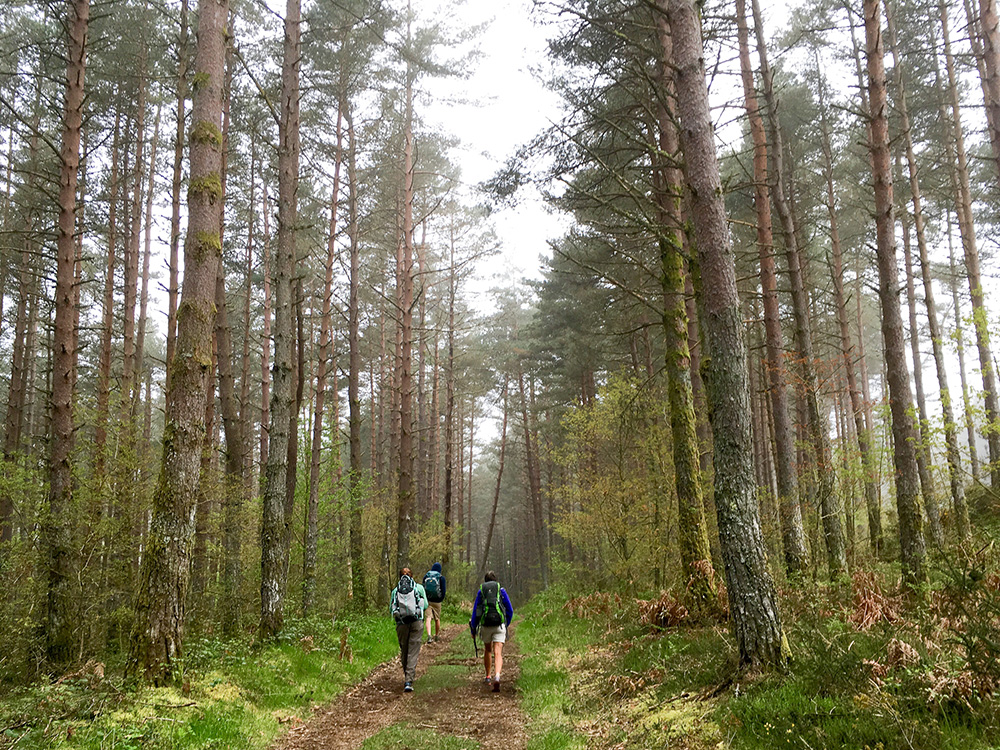All photos courtesy of uncorneredmarket.com
The Camino de Santiago, or “Way of St. James,” has enticed pilgrims for more than 1,200 years. Traditionally a religious pilgrimage, the Camino today attracts people from all over the world, of all different backgrounds and ages. There’s good reason why. The Camino creates a shared goal that connects and unites people, no matter where they come from or why they happen to be walking.
On the surface, undertaking the Camino may appear to be only a physical journey. However, the full experience is really about embarking on an emotional or life journey. It is perhaps the simplicity and ritual of walking, day after day, that allows one to disconnect from everyday life, and create space to reconnect differently with ourselves and the world around us.

At the bridge of St. James, the beginning of our Camino.
All Camino-walking philosophy aside, a significant question for those preparing themselves for the Camino is, often, what to pack? The simplicity of the Camino — it’s not a strenuous or exceptionally challenging hike — helps emphasize how little one needs on a day-to-day basis. It’s important to not carry a lot, but instead to carry the right gear so you are prepared. Note: the packing list or advice below can be applied whether you are carrying your own backpack during the day or your luggage is transported for you, as it is with all G Adventures Camino tours. Additionally, it can be used whether you walk 100km (62 mi) or go all out and walk close to 1,000km (621 mi), as we did.
Consider your Camino clothing in three categories: walking, evening, and sleeping. If you keep each category separate, it simplifies decisions about what to wear when. And it’s OK to wear the same thing over and over; everyone does it. Plus, packing light allows you to focus your time on things other than the decision of what to wear that day. Here’s what we recommend bringing:

The scallop shell, symbol of the Camino, guides the way to Santiago.
Hiking/walking shoes: The comfort of your feet takes on a new importance when walking many kilometres per day. It’s likely you’ll get blisters and feel pains in places you never even knew existed (we know this from experience). If you bring a pair of hiking or walking shoes that are broken in (this is important!) and offer considerable support, you’ll lessen the chance of getting very bad blisters.
If you have weak ankles, consider wearing medium-height or high hiking boots. Also consider bringing an ankle brace for even more stability and support.
Socks and liners: Everyone has their own strategy for what works best for their feet and shoes. I found that using sock liners (ankle-high running socks) together with wool hiking socks was the best combination: it cushioned my feet, and kept them dry (Dan’s feet did best in trekking compression socks). Play around before you leave for the Camino and figure out what makes your feet happy. Then, bring three pairs of each.
Quick-dry T-shirts: You can also wear cotton t-shirts if you like. However, quick-dry technology wicks away sweat and water, minimizing the time you’ll spend walking in damp shirts. You’ll only need a couple of these, since you can alternate them during the days and then wash them in the evening so that they dry overnight.

The Camino takes you through villages, giving you a real taste of local life.
Hiking pants/shorts: If you walk the Camino in the summer, you’ll likely be in shorts the entire time. However, if you decide to go in spring or autumn, temperatures fluctuate. You might be more comfortable in pants. We like hiking/trekking pants that have several secure pockets to hold a smartphone, wallet, maps, or other papers. Some may also prefer to walk in leggings or exercise pants.
Underwear: Pretty self-explanatory, but it’s important to mention all the same. We recommend quick-dry versions so that they can be washed and dried overnight.
Long-sleeved shirt and fleece jacket: Mornings and evenings can be a bit chilly, so carrying layers with you on the Camino is integral. When we walked the Camino del Norte and Camino Primitivo in the springtime, temperatures varied quite a bit during the day. We often began with three layers on top in the morning, and peeled down to one an hour or two later.
Rain gear: You never know when the heavens will open up, even during dry season. Bring a poncho or waterproof jacket to protect you on top, and light waterproof or water-resistant pants (we find light cycling rain pants work well) to keep your legs dry. If you walk in shorts, you may opt to just get wet rather than deal with the hassle of pants at all.
In addition, be sure that that your daypack or backpack has a rain cover, and place anything of value inside a Ziploc or similar type of resealable plastic bag.
Sun protection: There are large segments of the Camino where there’s no cover, so you’ll face a bit of sun exposure. Protect yourself with a hat, sunglasses, and the highest SPF sunscreen you can find.
Flip-flops or river sandals: At the end of a long day of walking you’ll want to get your feet out of your hiking shoes as quickly as possible. That’s when you’ll be glad you packed flip-flops or river sandals. In addition, if you are staying in group accommodation, these come in handy for shared showers and bathrooms.
Backpack/daypack: Whether you are carrying your own backpack with all your stuff during the day, or just a daypack, be sure that your pack fits your back properly (this is especially important for tall people). Your pack should feature a comfortable waist strap to take the weight off your shoulders and back. In addition, it should hold a water bladder or have place for a water bottle on the side for easy access (Most bars and cafés along the trek will fill it for you for free if you ask nicely).

Enjoying the silence of the forest.
Trekking pole(s): Although we didn’t use our trekking poles all of the time, we liked knowing we had the option. They came in handy when we hit mud, or steep, rocky declines. Additionally, when Dan hurt his ankle, the trekking pole served as a stabilizer and shock absorber. If you have weak knees or ankles, consider bringing a single pole or set with you. Leatherman and camping silverware/spork: We sometimes opted for picnics made from cheeses, meats, vegetables, and fruit from the local grocer or market rather than stopping for a proper lunch or menu del dia (usually a three- to four-course meal). Carrying a Leatherman (or similar Swiss Army Knife-type tool), and having silverware allowed us to assemble sandwiches, salads, and other snacks on the fly. Note: if you are planning on doing picnics, consider carrying a small plastic bottle of olive oil with you. Olive oil makes bread, sandwiches, and salad that much tastier. It’s worth the weight. Trust us.
Bandages, duct tape, and Compeed: As mentioned earlier, your feet may break out in blisters in ways that shock you. However, you can take steps to avoid or lessen the pain. From the moment you feel a hot spot develop, put duct tape or a bandage on it to prevent it from transforming into a full-on blister. If you end up with a blister, stop in a pharmacy along the Camino and pick up a package of Compeed. It’s a sort of skin replacement that not only prevents the blister from rubbing and getting infected, but also helps it heal.
At the conclusion of your Camino, when you reach Santiago de Compostela, you may be tired, but you’ll also feel a wonderful sense of accomplishment. You’ll be glad you packed light, but well. And it’s likely that you’ll want to continue the Camino spirit: You won’t want the ritual and rhythm of walking and the feeling of community to end just yet. There’s a reason why so many people walk the Camino several times in their lives. Buen Camino!
Getting there
Ready to walk the Camino? G Adventures can get you there. Check out our Walk the Camino de Santiago tour here.























